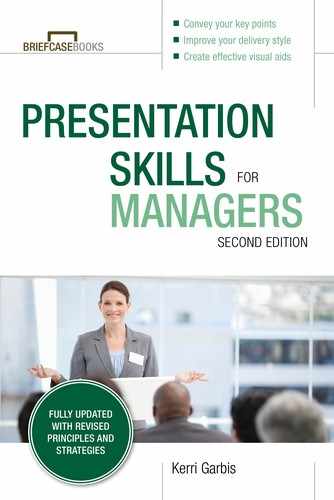
Acting Techniques That Help You Create Content
When on stage, an actor’s job is to change another person’s perspective. He or she tries to get someone to do something and, hopefully, feel something. This objective may be focused on a scene partner or the audience at large. A successful combination of a good script and an effective performance causes change. Without change, there’s no point to any play.
In business presentations, the goal is the same. You inform an audience so that they react to your message and somehow change their perspective. If you’re successful, they react the way you want them to. In this chapter, we’ll introduce you to the tools you need to help you discover the overall goal of your presentation and how you will achieve it.
Identifying Your Presentation Objectives
You want your audience to do something with the information you give them. Without a clear mission, there’s no reason for your presentation.
Identifying your presentation superobjective is the first step toward creating your content. Where do you start? Begin by answering this question:
“When my presentation is over, what’s the main thing that I want my audience to do?”
The answer to this question is your superobjective.
Using Presentation Strategies
Tactics are steps actors take to get what they want—how they will achieve their objectives. These steps are actions and best described using verbs, such as: to excite, to plead, to warn, to encourage. Tactics can also take the form of humor (to joke) and unique experiences (to share a personal story).
Actors choose their tactics based on the objectives they have planned for their character. Do the same with your presentation. Each objective has a set of tactics to go with it.
Feelings, Nothing More Than...
We can’t discuss presentation skills without talking about feelings. Many presenters feel this should be the main focus of their efforts. They think, “I want my audience to feel happy!” or “I want them to love my work.” When it comes to feelings, actors know a big secret: you can’t make another person feel something.
So, do we just throw feelings out the window? Absolutely not. As a presenter, the way to forge emotional connection, to hopefully help your audience have “feelings” about what you’re telling them, is to be clear about what you, as the presenter, are doing. It may sound a bit heady, but there’s a big difference between trying to excite someone and trying to make someone “feel” excited. One is forward moving and goal oriented; the other is simply working for an effect. This difficult idea will become clearer throughout this book.
Tactics are how you achieve your presentation strategies. They help you put action words to your content so you can attain your superobjective.
Here’s a superobjective example: Get the team to embrace a leadership change.
Let’s zoom in on one of the objectives:
Objective: Introduce the new leader.
Tactics: Defend the decision to make the change.
Outline how this will be a positive change.
Having trouble identifying tactics? Take another note from the acting world and find obstacles. Obstacles to your presentation are the people, things, or events standing in the way of you achieving your objectives. As a presenter, when you identify what is standing in the way of your communication, you can better choose which tactics are needed to deal with it.
Here’s an example of these three pieces in action:
Superobjective: To get my audience to embrace an impending leadership change.
(Obstacle: The team really likes the current CEO.)
Tactics: Encourage the team with the new leader’s past performance. Connect with them by praising the old leader.
Objective: Introduce the new leader.
(Obstacle: Team fears losing their job with this change.)
Tactics: Calm their fears with information.
You’ve now identified and articulated your superobjective, objectives, and tactics. We’re ready to begin content development in the next chapter.
Manager’s Checklist for Chapter 5
![]() Identify your superobjective and objectives.
Identify your superobjective and objectives.
![]() Identify known and potential obstacles:
Identify known and potential obstacles:
![]() Anticipate specific questios from your audience.
Anticipate specific questios from your audience.
![]() Identify environmental changes that may occur between planning and presentation delivery.
Identify environmental changes that may occur between planning and presentation delivery.
![]() Identify at least two tactics per objective.
Identify at least two tactics per objective.




